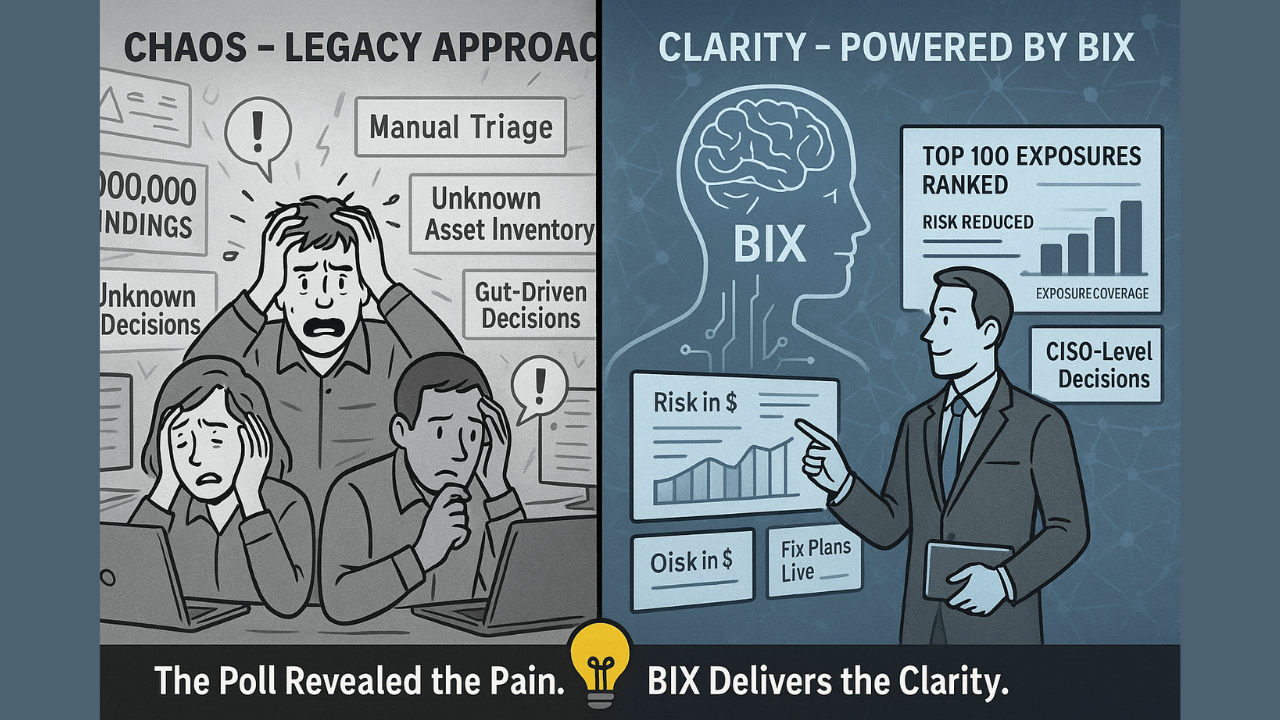

July 4, 2025
In our recent webinar, “BIX: AI That Thinks Like a CISO,” we explored how AI can operate with the same urgency, context, and decision-making precision as a seasoned security leader. From asset prioritization to vulnerability management to risk quantification, the session showed how AI isn’t just assisting—it’s thinking strategically, just like a CISO would.
This piece should be obvious: ChatGPT can’t tell you how a CVE impacts your environment. It wasn’t trained on your assets, your exposures, or your controls.
But AI trained with your enterprise context, built for cyber risk, and engineered to think like a CISO? That’s a different story entirely.
This is the AI shift—from general-purpose tools to domain-specific intelligence that speaks the language of risk, exposure, and action.
To make the session more engaging, we polled the audience with 8 sharp, self-reflective questions designed to assess confidence, visibility, and control coverage in their environments.
The responses uncovered key gaps—and massive opportunities for change.
Here’s what we found:
78% of respondents were either not confident or had no idea.
If a CISO can’t pinpoint their top exposures, how can they prioritize? Asset clarity is foundational, but elusive when asset data lives across multiple tools.
How BIX helps: BIX continuously ingests and normalizes asset data, ranks risk by exploitability and business impact, and surfaces the top threats automatically.
Only 22% said they could fully show which exposures were tracked versus blind spots.
How BIX helps: With full audit trails, exposure histories, and real-time visibility, BIX ensures you always know what was known, when—and what wasn’t.
67% said it takes at least several days or longer to find the 500 exposures that actually matter, and 80% of these said they were not very confident about their prioritized list.
How BIX helps: BIX filters out noise by correlating scanner findings with exploitability, compensating controls, and business context—prioritizing what matters most.
Nearly half said they still use patch counts or SLA compliance as their metric.
How BIX helps: BIX enables true exposure reduction tracking—connecting remediation efforts to meaningful risk deltas over time.
71% said that would be a game-changer. Only 8% claimed they’re already doing it.
How BIX helps: With automated prioritization, impact scoring, and recommended fixes, BIX cuts down triage time dramatically.
85% said they use manual tracking or have no process at all.
How BIX helps: BIX maps compensating controls, flags unfixable risks, and keeps them visible and reportable.
Only 12% said they could confidently quantify which investments reduce the most risk.
How BIX helps: BIX quantifies control effectiveness and shows which investments move the risk needle.
91% said they either rely on manual effort or have no clear visibility across EDR, MFA, and segmentation.
How BIX helps: BIX gives unified visibility across assets, controls, and coverage—with drill-downs by business unit, control type, or exposure category.
These aren’t just stats. They’re symptoms of a broader shift: Security teams can no longer keep up with modern threats using static tools, patch spreadsheets, or tribal knowledge.
You need AI that doesn’t just surface data—but thinks like a CISO. That means understanding context, modeling risk in dollars, and pointing to what matters right now.
The future of cybersecurity isn’t about dashboards. It’s about decisions.
Conclusion: The poll results speak for themselves. Security teams are still buried under data, stuck in spreadsheets, and struggling to connect the dots between vulnerabilities, exposures, and business impact.
AI that thinks like a CISO isn’t a nice-to-have—it’s a strategic advantage.
Watch the full on-demand webinar: Inside BIX: AI That Thinks Like a CISO